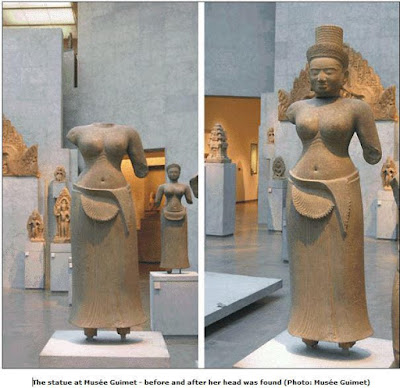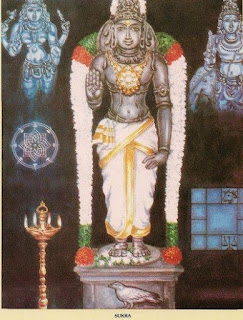Broken Statue of Shakti Miraculously Rejoined in Paris
After 500 years, 'sheer chance' reunites the head and body of a Hindu statue in Paris.
The wife of the Hindu God Siva, Shakti, decapitated in Cambodia in the 15th century, finally has Her head back, after it was discovered 500 years later on the other side of the world. A Paris museum dedicated to Asia, the Musee Guimet, is celebrating the implausible chain of events that reunited a divided masterpiece of ninth-century Cambodian art.
The headless body was found by French archaeologists near the shattered temple of Bakong, amid the celebrated Angkor ruins, in 1935. The statue has been exhibited since 1938 at the Musee Guimet in the Place d'Iena in Paris, which has the finest collection of ancient Khmer artifacts outside Cambodia.
Last autumn, the museum held an exhibition on Vietnamese art which paid tribute in its catalog to a retired American diplomat, John Gunther Dean. The catalog recounted Mr. Dean's efforts, as ambassador to Cambodia in the early 1970s, to rescue ancient Khmer art from the ravages of the Khmer Rouge, which was determined to expunge all records of Cambodia's past.
To thank the museum, Mr. Dean, now 80, offered a gift from his own collection of ancient Khmer artifacts. Last month, the gift arrived, the sculpted head of a woman found at the Bakong temple site in 1939.
"I asked him for a Khmer head because we only had headless statues but I didn't think for a moment about a possible match," said Pierre Baptiste, the museum's curator for south-east Asian art.
"I brought the head into our [Cambodian] hall looking for a place that it could be exhibited," said M. Baptiste. "I had a sudden notion the two pieces resembled each other but then thought, 'No, things never happen that way.'
"I put the head on the statue's shoulders. It shifted a few millimeters. I heard the little click that you get when two stones fit together and the head fell perfectly into place. It was as if it had put itself together. I still get goose-bumps thinking about it."
The reformed statue, which is 4ft 10in high, was beheaded in the temple when it was destroyed in the 15th century.
The headless body was found by French archaeologists near the shattered temple of Bakong, amid the celebrated Angkor ruins, in 1935. The statue has been exhibited since 1938 at the Musee Guimet in the Place d'Iena in Paris, which has the finest collection of ancient Khmer artifacts outside Cambodia.
Last autumn, the museum held an exhibition on Vietnamese art which paid tribute in its catalog to a retired American diplomat, John Gunther Dean. The catalog recounted Mr. Dean's efforts, as ambassador to Cambodia in the early 1970s, to rescue ancient Khmer art from the ravages of the Khmer Rouge, which was determined to expunge all records of Cambodia's past.
To thank the museum, Mr. Dean, now 80, offered a gift from his own collection of ancient Khmer artifacts. Last month, the gift arrived, the sculpted head of a woman found at the Bakong temple site in 1939.
"I asked him for a Khmer head because we only had headless statues but I didn't think for a moment about a possible match," said Pierre Baptiste, the museum's curator for south-east Asian art.
"I brought the head into our [Cambodian] hall looking for a place that it could be exhibited," said M. Baptiste. "I had a sudden notion the two pieces resembled each other but then thought, 'No, things never happen that way.'
"I put the head on the statue's shoulders. It shifted a few millimeters. I heard the little click that you get when two stones fit together and the head fell perfectly into place. It was as if it had put itself together. I still get goose-bumps thinking about it."
The reformed statue, which is 4ft 10in high, was beheaded in the temple when it was destroyed in the 15th century.



Comments
Post a Comment